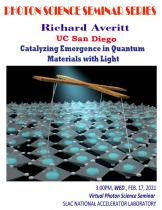Speaker: Richard D. Averitt, UC San Diego
Program Description:
Quantum materials manifest fascinating phenomena ranging from superconductivity to metal-insulator transitions. Many of these materials exhibit colossal changes to external perturbations which includes electromagnetic excitation. This opens up exciting possibilities for “on-demand” control of emergent properties using light. Following a global overview of this topic, I will present vignettes from my research group highlighting the potential of light to explore quantum materials. The primary focus will be on correlated transition metal oxides. From equilibrium and non-equilibrium perspectives, such materials offer enormous possibilities for light-based discovery and control arising from delicate interplay between interactions and dimensionality.
BIO:
Richard Averitt received his PhD degree in Applied Physics from Rice University in 1998 for work on the synthesis and optical characterization of gold nanoshells. Following this, Richard was a Los Alamos National Laboratory Director’s Postdoctoral Fellow where his work focused on time resolved far-infrared spectroscopy of strongly correlated electron materials. In 2001, Richard became a member of the technical staff at Los Alamos, and in 2005 a member of the Center for Integrated Nanotechnologies co-located at Los Alamos and Sandia National Laboratories. In 2007, Richard joined Boston University as a faculty member in the Department of Physics and the Boston University Photonics Center. Since 2014, Richard has been with the Department of Physics at UC San Diego. Richard’s research is primarily directed towards characterizing, creating, and controlling the optical and electronic properties of quantum materials. This includes transition metal oxides and metamaterials.





